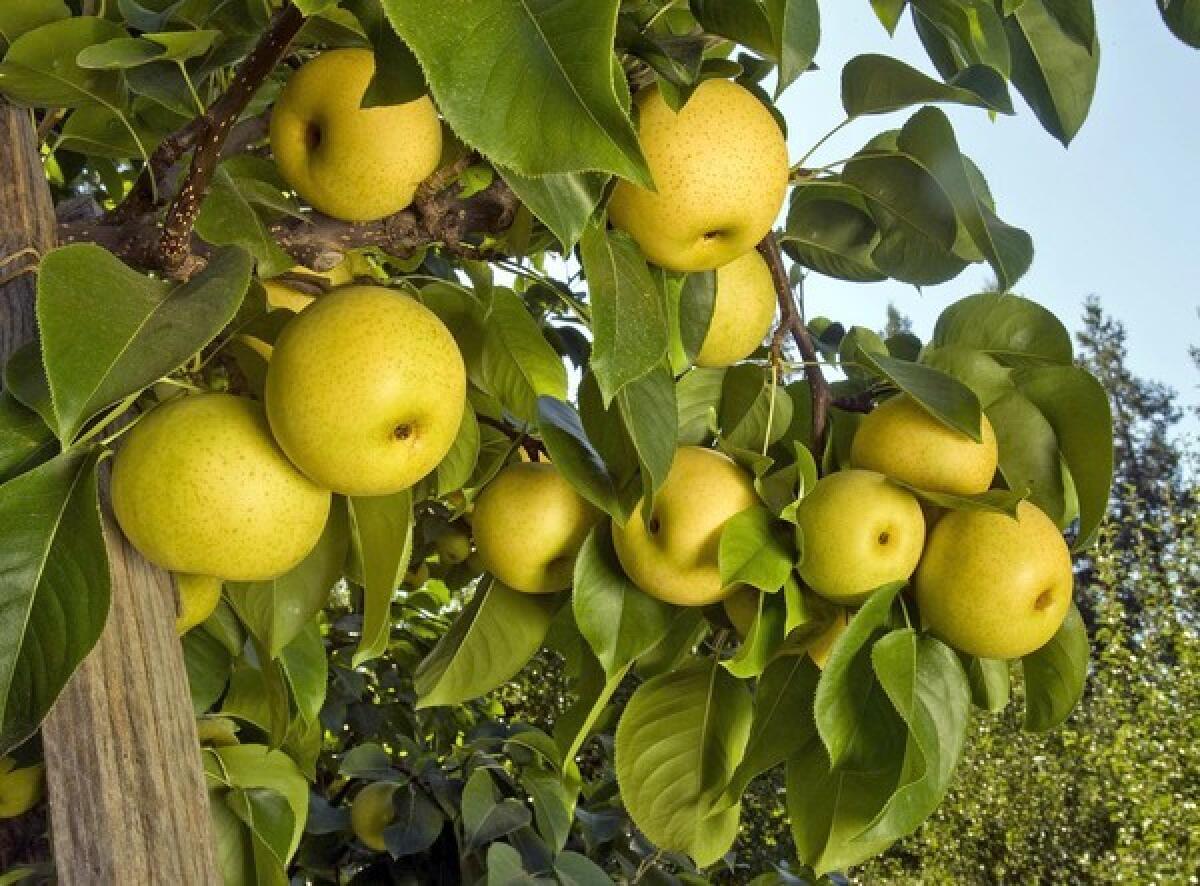Market Watch: Prime time for Asian pears

- Share via
Asian pears, like many fruits, are available year-round from storage and imports. But they are really at their best during the heat of late summer and early fall, when their delicate flavor is freshest and a juicy, crunchy fruit straight from the refrigerator is most refreshing. Even though they’re often marketed as “apple pears” — which seems plausible, since they’re generally round and are eaten firm and crunchy like apples — Asian pears are not hybrids at all, but belong to pear species that are native to Asia, most often Pyrus pyrifolia, and distinct from the European pear, P. communis.
Asian pear varieties differ considerably in texture, flavor and season. My favorite at this time of year is Shinseiki, which has light yellow skin speckled with tan dots, a mild sweet flavor and hard flesh.
Brighter yellow Shinseikis are sweeter than pale or greenish fruits, which can be bland. However, darker yellow color sometimes is due to accelerated ripening caused by damage from coddling moth, a common pest that enters through the blossom end and burrows into the core. When buying Asian pears, check this end around the leafy calyx for signs of intrusion, or ask the grower to select uninfested fruit.
No inspection is foolproof, however, so when you eat the pear, slice it into sections to make sure no pest is present, and cut out the toughest parts of the core. But leave the tender part next to the core, which is tarter than the rest of the fruit and thus provides a pleasing counterpoint. The skin of light-colored varieties is thin and edible.
PHOTOS: David Karp captures what’s fresh this week at local farmers markets.
Where it is grown is less important for Asian pears than for other crops like figs and grapes, and the major commercial district, the San Joaquin Valley, produces perfectly good fruit. But there is some advantage to Asian pears from the mountains and foothills, where temperatures drop at night, giving the trees more opportunity to respire and the fruit a chance to develop full flavor and sweetness.
Many immigrants from Japan planted Asian pear orchards in the hills east of Sacramento starting a century or more ago, and although most of these have fallen out of production, Jeff Rieger of Penryn Orchard Specialties bought one of these old farms and takes an almost fanatical pride in his fruit. At the Santa Monica Wednesday market he is selling Shinseiki and another early variety, Kosui, which has golden brown skin on a pale green to yellow background and is sweet, juicy and delicious.
The season has just started for the most popular russet-skinned Asian pear, Hosui, which is less firm than Shinseiki, but much more juicy, sweet and aromatic — a candy bar compared with a cool drink of water. The skin of Hosui and most other brown varieties is edible in theory, but thick and tough, so these fruits are best eaten peeled. Becky Terry of Terry Ranch, from Dinuba, does an excellent job with Hosuis, which she will start selling this Saturday at the Santa Monica Organic market.
Lima beans
Fresh Fordhook lima beans, delicate, moist and sweet, from McGrath Family Farm of Camarillo, are back in season. Phil McGrath has put in eight plantings, staggered to mature every two to three weeks, so at any given market, beans may be very tender but tiny, just right or slightly overmature and getting dry and starchy. His stand usually sells both whole beans in their pods and shelled beans, fed through an automated shucker. The latter are more expensive and spoil more quickly but are much more convenient. They’ll be available for the next several months at the Topanga, Ojai, Camarillo, Beverly Hills, Silver Lake, Hollywood, South Pasadena, Newport Beach and Santa Monica Wednesday farmers markets.
Fruit fly quarantine
Exotic fruit fly quarantines seem to be increasingly common at local farmers markets, forcing shoppers to paw under netting to access produce. The latest, for Oriental fruit fly was imposed by the California Department of Food and Agriculture and the U.S. Department of Agriculture on Aug. 5, and covers 89 square miles in and around Pasadena. It encompasses six farmers markets: Victory Park, Villa Parke and South Lake in Pasadena, and South Pasadena, Sierra Madre and Alhambra. The quarantine is projected to be in effect for about eight months, says Steve Lyle, a spokesman for the CDFA.
As with other quarantines, vendors must drape insect-proof netting over displays of host produce, which cannot be brought back to the farm. Customers are urged to keep such items inside the quarantine zone to keep the pest from becoming established, spreading and causing great economic harm to farmers.
Most growers have dealt with such quarantines before and already have the netting and other equipment needed to deal with this one, says Gretchen Sterling, manager of the Pasadena farmers markets.
The CDFA will combat the infestation by posting pesticide-laden bait stations on utility poles and street trees, to lure male Oriental fruit flies and kill them before they can breed.
The fruits and vegetables attacked by the pest include most of those subject to the current Mediterranean fruit fly quarantine in the Santa Monica area, such as peaches, grapes, apples and tomatoes. But there are some differences: cucumbers, Persian mulberries and cactus pears are hosts of the Oriental but not the Mediterranean fly; the opposite is true for kiwis and cherries.
Meanwhile, the Santa Monica quarantine, established last November, is likely to end soon if no new Medflies are discovered in the area. Managers of affected markets have been told informally that the restrictions might end Aug. 23 to 27, but the CDFA’s Lyle says only that the date “should be soon.”
More to Read
Eat your way across L.A.
Get our weekly Tasting Notes newsletter for reviews, news and more.
You may occasionally receive promotional content from the Los Angeles Times.










